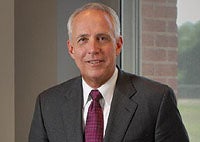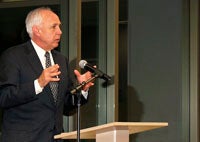Transforming Medical Education

Posted in GUMC Stories
 At the inaugural Georgetown University Medical Center (GUMC) – MedStar Georgetown University Hospital medical education ground rounds on February 9, 2012, Darrell G. Kirch, M.D., president and CEO of the Association of American Medical Colleges, gave a sobering assessment of the current state of the country’s health care system and the need for transformation. Academic medicine must lead this transformation, he said.
At the inaugural Georgetown University Medical Center (GUMC) – MedStar Georgetown University Hospital medical education ground rounds on February 9, 2012, Darrell G. Kirch, M.D., president and CEO of the Association of American Medical Colleges, gave a sobering assessment of the current state of the country’s health care system and the need for transformation. Academic medicine must lead this transformation, he said.
From Where We’ve Come
Kirch discussed the history, legacy, and culture of medical education, an arc of progress, and he pointed to three significant events that created a culture he believes should be changed.
The Flexner Report, published in 1910 under the aegis of the Carnegie Foundation, laid the groundwork for medical education reform at that time, calling for higher standards for admission to and graduation from American medical schools, with strict protocols for scientific teaching and research. However, Kirch said, an unintended consequence of the report was to cause medical education to place more value on a closed culture that focused inward and having limited engagement with an institution’s larger community.
In 1965, President Lyndon B. Johnson signed in to law Medicare — the health insurance program administered by the federal government for people age 65 or older or young individuals with certain disabilities. An unintended consequence, according to Kirch, was that it promulgated a fee-for-service medical culture in which doctors are rewarded most when their patients are sick, not well.
The third significant event Kirch noted was the appointment by President Ronald Reagan of Dr. James Wyngaarden as director of the National Institutes of Health (NIH). Wyngaarden was a champion of science, and he led the effort to more than double the NIH’s funding during his tenure. But his legacy created a culture that places a great deal of value on the individually funded researcher. “This may have created great science,” but Kirch questioned, “… is it the best thing for the nation’s health care system?”
Economics
Kirch then turned to economics. In 2011, the United States spent $2.71 trillion, or 17.7 percent of the nation’s gross domestic product on health care. He said that averages out to $8,648 per person and added that health care costs are rising 1.5 times faster than wages. At the same time, he pointed out, 49.9 million Americans remain uninsured. And compared to other developed nations, the U.S. is in the bottom third in life expectancy, the 4th highest in infant mortality, and first in adult obesity.
Transforming Education and Culture
 Kirch said academic medicine must continue to shoulder the responsibility to improve health care in the U.S.
Kirch said academic medicine must continue to shoulder the responsibility to improve health care in the U.S.
Kirsch called for the creation of a “true” health care system, one that will require a new approach to almost everything we do in medicine, beginning with rethinking our approach to the medical education continuum—the path from premedical education to clinical practice.
Key to accomplishing that, he added, will be transforming the culture of academic medicine, which remains essentially a hierarchy of competitive experts. The new culture, he said, must be patient centered, collaborative, and accountable.
The way many currently measure excellence among medical schools, he noted, is with a ranking system managed by a commercial magazine. Kirch emphasized that instead of measures such as size, mean MCAT exam scores, and amount of research funding, medical schools and academic centers should be measured by a better definition of excellence that considers mission, outcomes, service to the community, and the emphasis on building a system of wellness and prevention. Medical education isn’t about finding people who can memorize the facts—it’s about finding people who can help patients the most, added Kirch.
Kirch also explored whether or not GUMC and MedStar are demonstrating what he called the “new excellence.” He credited the interprofessional, interactive, and global attributes of medical education at Georgetown, and the patient-focused quality care culture of the MedStar hospital system. He noted the focus at both institutions on reducing health disparities (which he says is a critical component of improving health care quality), as well as community service, prevention, and the shared tradition of cura personalis.
At the end of the presentation, Kirch challenged the audience to think about the ideal future of academic medicine. “As future leaders, what do you think it ought to look like?”
By Frank Reider, GUMC Communications
(Published March 1, 2012)
